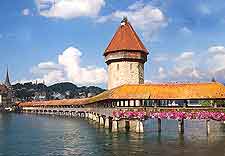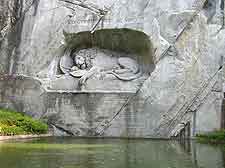Lucerne History Facts and Timeline
(Lucerne, Switzerland)

The popular Swiss city of Lucerne holds a fairly typical history - one of Roman origin, religion, disputes, plagues, revolutions, war, and more recently, tourism.
Following the demise of the Roman Empire, the already established settlement based in this part of Switzerland remained. In the middle of the 8th century, a Benedictine monastery was built to honour St. Leodegar and this small settlement was named 'Luciaria', later to become 'Lucerne'. Ownership of the monastery passed to Murbach Abbey, located in southern Alsace, just over 150 km / 93 miles away and to the north-west.
Founding and Independence for the Town
In the year of 1178, the settlement broke free from its rule by the Murbach Abbey and the town of Lucerne was officially founded shortly afterwards. Partly due to its well-placed setting close to the busy mountain pass of St. Gotthard, by the end of the 13th century, more than 3,000 people had chosen to call this town their home. King Rudolph I von Habsburg of Germany (former Duke of Austria and Styria) took control of the monastery, as well as the town.
The locals reluctantly accepted their new Habsburg ruler, although plotted for independence. This was finally achieved in 1332, when Lucerne joined with the surrounding cantons of Schwyz, Unterwalden and Uri to form the alliance known as the Eidgenossenschaft (Swiss Confederacy), marking a real turning point in its history. It was at this time that the famous Chapel Bridge (Kapellbrücke) was built to span the Reuss River. The Swiss Confederacy was soon joined by the likes of
Berne and
Zurich, forming an unusual and solid union of allies.
The Swiss Confederacy
Lucerne became an important member of the powerful Swiss Confederacy and its position was further strengthened when it gained a political and feudal status, awarded by Sigismund, a Holy Roman Emperor. A local government now ruled over the town, taxes were collected and official buildings constructed. All was going well until the middle of the 14th century, when wars and the Black Plague saw the town's overall population almost half, to less than 2,000.
Up until this point, Austria had been ruling over Switzerland and this country chose to make a hasty retreat after their defeat at the 1386 Battle of Sempach. Lucerne became a popular town, admired for its position in the confederacy, and as a result, many people wanted to live here. Much expansion was enjoyed in the early 16th century and a new influx of tradesmen, farmers and artists added their talents to the pot.
The 1653 Swiss Peasant War was to be followed by further sieges, due to the town's strong religious beliefs. Lucerne was one of the few cities in Switzerland to follow the Roman Catholic religion, and after the Protestant victory at the 1712 Battle of Villmergen, the town took on a more diminished role in the confederacy.

Revolutions in History
The French Revolution in the 1790s witnessed much of Switzerland occupied by France. As a result, the Swiss Confederacy was disbanded and the powers taken away from local governments. The French soon left and Lucerne fell behind other towns and cities in Switzerland, who were already embracing the start of the industrial revolution.
Lucerne continued with its agricultural trade, although, in the 1860s, just after the railway came to town (connecting
Basel and Olten), it finally followed suit and factories were born. Over the next 50 years, the population doubled, and then doubled again. The 'good times' brought much wealth to Lucerne, along with an improved infrastructure and some very attractive buildings.
Due to Switzerland's neutral status, the two World Wars rather passed Lucerne by. Hitler considered invading Switzerland on a number of occasions, but his troops never actually attacked. After the war, it took a good decade for the Swiss to improve relations with bordering countries, who had objected to its neutrality and stance.
More Recent Times in the City
Lucerne history was to expand once more, when the city voted to extend its boundaries to the neighbouring town of Littau in 2007. As a result, the city's healthy population is now in the region of 75,000 people.
Tourists regularly head to Lucerne, keen to see its medieval remains and walk along its attractive Chapel Bridge. The bridge's appearance has remained quite unchanged in history for literally centuries - even though it needed to be rebuilt in the 1990s, after fire damage. Sightseers will enjoy checking out the Cathedral of St. Leodegar, built in the early 17th century, or perhaps taking a trip on the steep railway up the side of Mount Pilatus.
 The popular Swiss city of Lucerne holds a fairly typical history - one of Roman origin, religion, disputes, plagues, revolutions, war, and more recently, tourism.
The popular Swiss city of Lucerne holds a fairly typical history - one of Roman origin, religion, disputes, plagues, revolutions, war, and more recently, tourism.